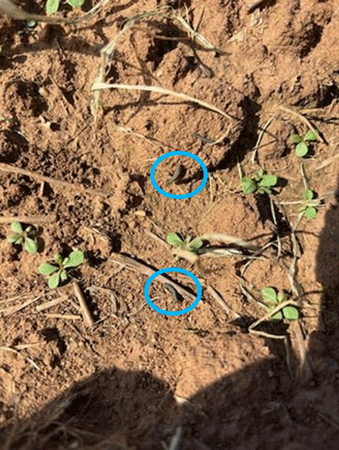Infestations of fall armyworm are causing problems in turfgrass, pastures, and other crops this year (Figure 1). Last fall, fall armyworm feeding caused patchy losses in newly emerged winter canola fields across central and southern Kansas. Thus, it is important to frequently scout canola in the seedling stage, especially if fall armyworms are active in your area. Early detection is important because larvae can quickly overtake emerging plants. Fall armyworms often move in from road ditches or weedy areas, so begin on the field edges and work your way to the interior. Look for windowpanes on leaves, stripped plants, cut plants, and areas where plant stands appear to be thinning. Once the growing point of canola is removed, the plant is lost and will not recover.

Figure 1. Fall armyworm feeding on volunteer wheat in a fallow field. Photo by Cody Swinehart, Kingman County.
The current crop of larvae is the second generation, and historically, there have been only two generations per year in Kansas. These larvae are close to maturity and approaching pupation, so they should be about finished feeding. The second-generation moths that emerge from these larvae will return south for the winter. However, the first generation occurred very early in a warm spring, so the second generation, which is less synchronous in development, also began earlier. If some of the early-matured second-generation moths start laying eggs, a partial third generation may be possible this year. It is unlikely any of these larvae would get large enough to mature, but they could still cause localized damage. The cue for southerly migration is shorter day length, with some interaction with temperature, and these conditions may not have been experienced by second-generation moths that emerged in August.
One way to minimize this risk would be to plant later, toward the end of the planting window. However, this risk assessment is based on our knowledge of fall armyworm biology and behavior and is entirely speculative - there is no historical reference. Delayed planting of winter canola has other risks, including the inability to develop the necessary top growth for overwintering.
Although no efficacy data exist for winter canola, seed treatments with chlorantraniliprole, cyantraniliprole, or imidacloprid have provided up to two weeks of control of fall armyworm on emerging corn. However, if feeding pressure is heavy on small seedlings, seed treatments may not prevent stand losses. Several common insecticides are labelled for fall armyworm control if needed before or after canola emergence (Table 1).
Table 1. Insecticide options for controlling fall armyworm in winter canola.
|
Chemical Name |
Trade Name |
Class |
Rate (fl oz/a) |
|
Bifenthrin (numerous products) |
Brigade 2EC |
3a |
2.1-2.6 |
|
Bifenthrin plus zeta-cy |
Steed |
3a |
2.5-3.5 |
|
Bifenthrin plus zeta-cy |
Hero |
3a |
2.6-5.5 |
|
Gamma-cyhalothrin |
Proaxis |
3a |
1.92-3.84 |
|
Gamma-cyhalothrin |
Declare |
3a |
0.77-1.54 |
|
Lambda-cyhalothrin |
Warrior II w/Zeon Tech |
3a |
0.96-1.92 |
|
Lambda-cyhalothrin plus chlorantraniliprole |
Besiege |
3a+28 |
5.0-10.0 |
|
Zeta-cypermethrin |
Mustang Maxx |
3a |
4.0 |
For more information on insects important to canola, see the “Great Plains Canola Production Handbook” available at https://www.bookstore.ksre.ksu.edu/pubs/mf2734.pdf.
The use of trade names is for clarity to readers and does not imply endorsement of a particular product, nor does exclusion imply non-approval. Always consult the herbicide label for the most current use requirements.
Mike Stamm, Canola Breeder
mjstamm@ksu.edu
J.P. Michaud, Entomologist, Agricultural Research Center - Hays
jpmi@ksu.edu
Anthony Zukoff, Instructor of Entomology, Southwest Research-Extension Center - Garden City
azukoff@ksu.edu